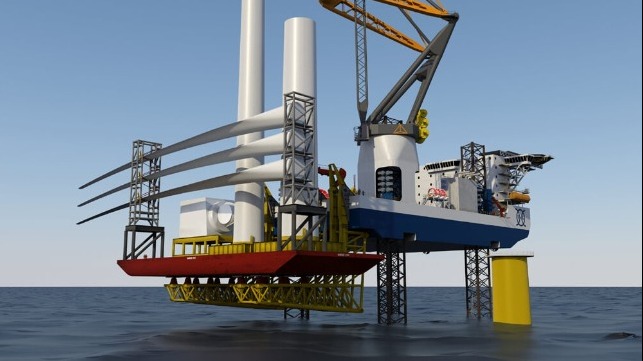Design for WTIV that Lifts Feeder Barge Gets ABS Approval

Designers are working to create new solutions to help support the anticipated rapid expansion of the offshore energy sector which calls for an increasing number of wind farm installations on tight schedules. In the latest development, American Bureau of Shipping has granted Approval in Principle (AIP) to a coordinated design developed by Friede and Goldman for a wind turbine installation vessel that would work in conjunction with a feeder barge system.
The designs said they drew on their long experience with jack-up vessels to develop a new approach that will extend the operational window on site while reducing costs and proving greater productivity for the installation operation. The design combines a barge, which can be built to be Jones Act-compliant, with a lifting system on the WTIV. The design was reviewed in accordance with the ABS 2017 Guidance Notes on Review and Approval of Novel Concepts.
“To achieve the scale of U.S. offshore wind market by 2030, the industry will be reliant on the delivery of the variety of vessels that will be needed to install and maintain the turbines, while navigating various port constraints,” said Greg Lennon, ABS Vice President, Global Offshore Wind. “This design from F&G is the latest where we are proud to be able to assist with our extensive knowledge of U.S. regulations and our deep involvement with the entire offshore wind supply chain here in the U.S.”
According to F&G, typical feeder vessels are inherently risky due to motions during turbine equipment handling. They noted that typically cargo can not be offloaded if a barge exceeds very low limits for its motion. This narrows the window for operation for the typical WTIV and is often addressed by the installation of costly high-tech equipment to dampen motion.
Friede & Goldman’s BargeRack is a unique feeder solution that eliminates barge motions. The barge comes alongside loaded with wind turbine components and is elevated onto the WTIV. According to the designers, it will make the installation operations simple, safe, and optimized for maximum uptime by extending the operational weather window.
“F&G has developed a superior feeder vessel solution. Typical feeder solutions are inherently risky due to feeder vessel motions with the impact on equipment transfer. We’ve solved this problem by completely eliminating the feeder vessel motion, as well as reducing the feeder vessel cost by an order of magnitude compared to other feeder vessels,” said Robert Clague, Vice President of Engineering at F&G.
The BargeRack system can be built in the United States to meet Jones Act requirements and utilize existing U.S. infrastructure to maximize its efficiency.
